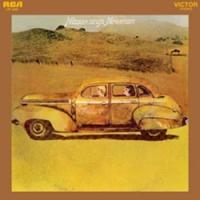"Nilsson Sings Newman" Issued By Speakers Corner on Quiet Vinyl For the First Time
I saw this crazy musical mashup in the Boston University gymnasium but I was already familiar with Randy Newman. I'd bought his first album in 1968 because his photo on the cover reminded me of me in 1964.
Not a great reason to buy a record but what a great record: string drenched, overproduced with vocals by Newman that were overwhelmed by strings. But Newman's droll sense of humor and songwriting brilliance shone through. The album flopped but was a critical success and other artists dug it and began covering Newman.
Harry Nilsson, who, unlike Newman could really sing, was one of Newman's early champions and in 1970 he recorded this very short, sweet album of Newman songs with the composer backing him on piano.
Sounds simple. Nonetheless this is a complicated production filled with hundreds of overdubs and if you listen and hear simplicity you just aren't listening.
After much rehearsing, the basic piano and vocal tracks were recorded at RCA's Music Center of the World in Hollywood beginning in August of 1969, with six sessions in all, ending in September. Nilsson worked manically fueled by cocaine. He did multiple takes to get everything as he envisioned it in his head. By the end Newman was exhausted and feared all of the spontaneity had been destroyed that makes a record great.
Nilsson got permission to remove the tapes from RCA (not easy to do!) and took them to Wally Heider's in San Francisco where he added overdubbed multi-part background singing and some unusual voice-over "instructions". It's as if you are listening both to the finished album and to the making of the album.
Nilsson covers "Vine Street" familiar to fans of Van Dyke Parks' Song Cycle, the pleasingly racist "Yellow Man," the depressing yet humor-laced life cycle tune "Love Story", the sincerely tender "I'll Be Home" and the wallow-in-the-misery "Living Without You," which was Newman's first tune to become a genuine standard. The album ends with the simmering with bitterness "So Long Dad". Also here is Newman's prescient "The Beehive State", which basically flips the bird at The Tea Party forty plus years ahead of its time. The only song written specifically for the album is "Caroline." Newman never recorded it. No one else has ever recorded it.
Nilsson wrings every drop of the ideal emotions from every one of Newman's ten songs, adding overdubbed background vocal harmonies, sometimes serious and soaring (end of "Living Without You"), sometimes imbued with the dark humor with which Newman's songs were saturated. He adds a drop of Glenn Miller's "Moonlight Serenade" in "Dayton, Ohio 1903" and finishes off "Cowboy" with a musical reference to "Midnight Cowboy", the soundtrack to which he contributed a cover of Fred Neil's "Everybody's Talking." Sprinkled throughout the album are "talk back" comments to the recording engineer and even lyrical encouragement from Newman.
Adding to the quirkiness is the back cover showing four guys "sitting" in the 1938 Graham automobile shown on the cover (head shots were pasted on a photo of the car). They are: Steve Barncard, recording engineer best known to some here for his work with The Grateful Dead and the engineer on David Crosby's "If I Could Only Remember My Name", Pat Ieraci A/K/A "Maurice" who engineered for The Jefferson Airplane and might be the "Pompatus of Love" guy to whom Steve Miller once referred, Michael Leary and Allen Zentz. All four plus Nilsson were required to mix the album because despite what sounds like a simple production, was an incredibly complex one that to correctly mix took the talents and endurance of all of them.
Best of all, here is the beauty of Nilsson's voice, recorded closely miked and sans effects or reverb. He's right on the mic and right in your room for most of it. His performances are astonishingly complex and ever-changing. The more often you listen the more that's revealed and the more you will appreciate. Doing so is made easy by a superb set of basic piano and vocal tracks, deft splicing and of course the overdubbed Nilsson chorale background singers.
Finding a quiet original, issued in 1970 when PVC was in short supply, is difficult. In fact, given the album's lack of success, finding an original period is not easy, so this reissue is welcome. It is very, very well done. Though not quite as transparent as the original, that is more than made up for by the ultra-quiet Pallas pressing. The original I have has a low level noise throughout caused by a poor vinyl formulation.
It's a short album. The reissue is costly. The cover art (the cover is by Dean Torrence of Jan and Dean fame) doesn't come close to the original: it's somewhat blurry, and the colors are off, but I so recommend this reissue. Sonically it's as good as it can get and you'll never tire of listening to it. I've got forty three years and counting and still loving it.




